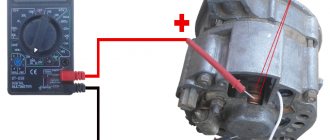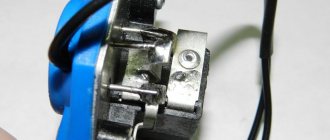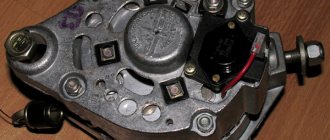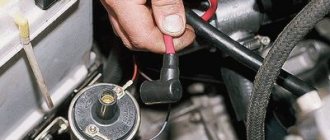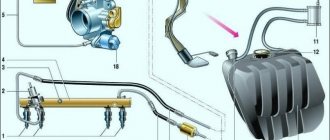Not every driver knows what a VAZ 2107 charging relay is; in addition, this device is extremely rarely remembered. The charging relay is a voltage regulator or “chocolate bar” that is located in the generator. Owners of the Seven only pay attention to this detail after problems with the battery not charging begin. To prevent it from happening at one point, which negatively affects the engine, it is necessary to periodically monitor the operation of the charging relay.
Purpose of the regulator relay VAZ 2107 injector and carburetor
The main purpose of the voltage regulator relay on the VAZ 2107, and any other car, is to maintain a stable and sufficient charging current for the on-board network and the car battery, as well as to level out voltage surges in the generator. Variations in the generated voltage would occur as the generator rotates at different frequencies. When the power drops below 12V, the battery stops charging, and the entire bot network no longer functions at 100%. If the voltage exceeds 16 Volts, this can lead to boiling of the battery, as well as failure of on-board devices.
On early production VAZ cars of the carburetor type, the voltage regulator is located on the left arch of the engine compartment. Such devices are also called external, since they were installed outside the generator structure. To be more precise, a brush mechanism was installed in the generator, and control was carried out via a printed circuit board, which was installed outside the product.
Most VAZ 2107 cars of the carburetor and injection type are equipped with generators with built-in charging relays. The charging relay on such VAZ 2107 vehicles is located directly on the side of the generator opposite the pulley.
To maintain an acceptable battery charge, the alternator requires 13.6 to 14.6 volts of power. The voltage regulation circuit is carried out using an electrical circuit, which is located on a printed circuit board (chocolate board) or in the form of a single semiconductor module (tablet) with brushes. The switch located inside the generator is usually not able to adequately respond to the ambient temperature due to its location close to the running engine. The built-in relay is sometimes replaced with a three-level voltage regulator, which is due to the greater efficiency of the product due to manual adjustment of the output voltage.
How to check the charging relay on a VAZ 2107
If you suspect a faulty operation of the voltage regulator relay, then you must first check the voltage at the battery terminals with the car running. The power supply must be no lower than 13 and no higher than 14.6 Volts. The reasons for such increased or decreased voltage can be caused by the following factors:
- charging regulator malfunction;
- failure of the generator itself;
- lack of contact in the electrical connections of the battery or generator.
To check the serviceability of the chocolate bar, it is necessary to remove it from the generator. This must be done by unscrewing two bolts.
It is important to know! Before you begin to remove the device, do not forget to remove the negative terminal from the battery.
To check the serviceability of the product, you need to connect a voltmeter or test lamp, as well as an adjustable power source of 12-22 Volts. You can use a power supply with a variable resistor. The control check of the regulator relay is carried out by connecting the minus wire from the regulated source to ground or terminal “Ш”. The positive wire of the power supply must be connected to terminal “B”. A voltmeter or lamp is connected to the brushes or relay output. If the product is in good working order, then when a voltage of 12 to 14 Volts is applied to it, the light will light up or the voltmeter will show similar values. If you apply power above 16 Volts, the light should go out. If the light bulb is constantly glowing, you can judge that the product is broken. The absence of a light bulb indicates a break in the relay. In both cases, the regulator cannot be repaired, so it needs to be replaced.
How can you check the product for serviceability without removing it from the car? To do this, you need to connect a voltmeter to the battery terminals, and then start the engine. If the voltmeter readings are below 12.7V or above 14.6V, then the probability of the chocolate bar failing is 95%. Replace the product with a new one, then check the voltage.
Checking the voltage relay
Checking the alternator voltage regulator is sometimes necessary when you start to see battery problems.
Specifically, it became overloaded or overloaded. If such a malfunction occurs, it’s time to check the generator voltage regulator relay. The relay should turn off at 14.2-14.5V. The task of this simple device is to regulate the voltage of the electric current that is supplied from the generator to the battery. In the event of a breakdown, the battery is not charged enough or, on the contrary, overcharged, which is also dangerous, as it significantly reduces the battery life.
Agree, this perspective is not very good due to the small detail. This is why it is so important to monitor the operating condition of the voltage regulator (it can also be called a tablet or a chocolate bar). But in order to properly check the voltage regulator, you need to know its type and some important characteristics.
Basic faults
The main reason for the breakdown of generator brushes is their wear, which makes itself felt by a poor battery charge. Replacing the gear shift lever of a VAZ 2107 - sent to a classic engine and transmission gentlemen, tell me what to do? The gear shift lever on a VAZ 2107 (5-speed) broke off. Replacing the generator brushes of a VAZ 2108 on your own. You can detect a failed part by the following problems:
- voltage failures;
- the battery discharges quickly or does not charge at all;
- the headlights begin to burn much weaker or blink;
- instrument lights blink;
- There is not enough voltage for the electronics to operate and it turns off (radio tape recorder, for example).
Checking an Individual Regulator
Checking the voltage regulator on the G-222 generator: 1 – battery; 2 – voltage regulator; 3 – control lamp.
As a rule, separate voltage regulators were installed on old cars, including domestic VAZs. But some manufacturers continue to do this to this day. The verification process is similar. To do this, you will need a power supply with a voltage regulator, a 12 V light bulb, a multimeter and a directly tested regulator.
To check, you need to assemble the circuit shown in the figure. The process itself is similar to that described above. In normal condition (at a voltage of 12 V), the light is on. When the voltage value increases to 14.5 V, it turns off, and when it decreases, it turns on again. If during operation the lamp turns on or goes out at other values, this means that the regulator has failed.
Checking relay type 591.3702-01
Test diagram for relay type 591.3702-01
In addition, you can also find a voltage regulator of type 591.3702-01, which was also installed on rear-wheel drive VAZs (from VAZ 2101 to VAZ 2107), GAZs and Moskvichs. The device is mounted separately and installed on the housing. In general, the control is similar to that described above, but the differences lie in the contacts used for this.
In particular, it has two main contacts: “67” and “15”. The first is a minus, the second is a plus. Therefore, to check it is necessary to assemble the circuit shown in the figure. The verification principle remains the same. In the normal state, at a voltage of 12 V, the light is on, and when the corresponding value increases to 14.5 V, it goes out. When the value returns to the original value, the indicator will light up again.
The classic regulator of this type is the PP-380 device, installed on VAZ 2101 and VAZ 2102 cars. We provide reference data on this regulator.
Why change brushes?
If signs of brush breakage are detected, they should be replaced. VAZ 2104 - 2107; replacing generator brushes on VAZ-2113, 2114, 2115. Without removing the generator. Repair of generator brushes on VAZ 2105-2107 models. Replacing the windshield of a VAZ 2107 with your own hands | auto-gid. If repairs are not carried out in a timely manner, there is a possibility that you will soon need to purchase a new generator, and this is a completely different expense. Replacing the brushes of the VAZ 2107 generator. Photo, instructions on how to do it. The battery can only hold the ignition without brushes for a few minutes, which means it will have to be constantly charged. Replacement of slip rings and bearings of the VAZ 2110 generator. And soon they will be replaced.
You can check the condition of the brushes by the size of their protrusion from the seat. Replacing the brushes of a VAZ 2107 generator is a simple procedure and usually takes a few minutes; replacing the brushes does not require removing the generator, just turn it off. If the protrusion size does not reach five millimeters , then they should be replaced immediately to avoid possible problems.
It is recommended to replace it every 50,000 km or every season, which is the key to safe operation of the vehicle. Replacing generator brushes in a Chevrolet Aveo. It is better to have a spare set of spare parts so as not to get into an unpleasant situation on the road and then call a tow truck.
Without removing the generator
If you are sure that the problem with the car breakdown is a malfunction of the generator brushes , then you can do without removing it.
- Turn off the negative terminal.
- Disconnect the wires.
- On the brush holder body, unscrew the two bolts holding it in place.
- We extract the structure.
- We check for damage and the size of the protruding part of the brushes (it must be at least 5mm).
- We install new elements and carry out installation in the reverse order.
With the generator removed
Poor charging of the car can be caused not only by the brushes, but also by the alternator belt. To eliminate this point, when replacing brushes
it should be removed to check the condition of the belt.
First, we dismantle the unit.
- We unscrew the bolt securing the generator belt.
- Move the unit towards the engine and remove the belt.
- Unscrew the tensioner bar and remove it.
- Disconnect the plug and terminals.
- We take out the part.
Replacement result
After replacement, errors may appear about a low battery charge or a malfunction of the generator; there is no need to immediately try to find the cause of the failure. This phenomenon is not uncommon, since new brushes have just begun to break in. What are the causes of Chevrolet Niva generator breakdowns? Chevrolet Niva replacement brushes are soldered to. After some time, everything will return to normal, and you can safely continue to operate the car.
Replacing the VAZ-2107 generator brushes is perfect as a training demonstration for those who do not yet consider themselves specialists, but are just learning the basics of car repair and maintenance. This information can be used not only to repair the “Seven”, but also for other models (VAZ-2110 and 2114). Now let's proceed to a more detailed study of the issue.
Generator brushes - why are they needed?
Quite often (especially in older models) there are cases when, with a sharp increase in driving speed, various seemingly inexplicable things happen: the light of the dashboard or headlights dims, the cigarette lighter and (or) radio work intermittently. Drivers who have not been hardened by many years of experience in the cold lake may mistakenly think about burnt fuses, wiring, or shorted devices. It can take a whole day or more to work through all these versions. But what will be the driver’s surprise when the true cause of the malfunction becomes clear, that the whole essence of the problem is due to some small pieces of black metal called generator brushes.
Generator device
Based on 9th or 8th grade physics lessons, everyone knows that any generator must include two main parts, one of which is movable (rotor), and the second, correspondingly, stationary (stator). Each part has a copper (in most cases) winding. Under the influence of magnetic force, the rotor begins to rotate, powered by electricity through the armature and two other metal parts. And they are called generator brushes. Due to the constant impact of friction, all parts gradually wear out due to the constant rotation of the rotor. This happens in any case, regardless of the quality of the material of the parts (and it is really strong).
Diode in the circuit
ATTENTION! I found a completely simple way to reduce fuel consumption! You won't believe me? Even a mechanic with 15 years of experience didn’t believe it until he tried it. Now save 35,000 rubles a year on gasoline! Read more"
Installing a diode with a toggle switch is the easiest way to increase the voltage. Don't worry, look up lots of information in books etc. Everything is as accessible as possible, without any special difficulties.
This option of increasing tension, despite its simplicity, gives the most reliable result. Ideal for domestic VAZ car models.
The purpose of this method of increasing the voltage in the vehicle’s on-board network is to deceive the regulator, which is located inside the generator. As you know, on old models of domestic cars (kopek, VAZ 2105, and so on), the voltage drop sometimes reaches critical values - sometimes it drops to 12.5 volts. The battery, naturally, will not be charged at such a voltage.
The voltage regulator is the same as brushes, tablets, chocolate - there are many names, but it is the same element responsible for regulating the voltage in the generator. On our domestic machines, mostly older ones, the tablets are of poor quality. They regulate the voltage poorly and, as mentioned above, sometimes the current value drops below the crankcase.
So, what you need to do is insert an additional diode into the circuit. Thus, we get the following: the more the voltage on the diode decreases, the more the regulator will increase the total current in the circuit.
There are several ways to embed a diode. One of the best is remote. Take a simple toggle switch and install it somewhere convenient.
Apparently the toggle switch had to go through the wire to the generator. The diode can be inserted into the gap in the generator bridge, where the wiring runs from the field winding to the regulator. That is, we simply cut the diode in the wiring between the bridge and the regulator.
We issue the toggle switch separately on a diode through two wires, as shown in the photo below.
When there is sufficient voltage in the on-board network, for example in summer, the diode is simply installed and not used. If the current is not enough, simply turn on the toggle switch, activating the diode. This way we deceive the regulator.
Diodes can be used as follows.
Their analogues, for example, imported ones, are also suitable. They are much more compact, made of plastic (case). Domestic - metal.
The diode can provide a voltage drop of 0.9 or 1.2 volts. Therefore, if the voltage drops to 13-13.6, the regulator will add about 1 volt. This is normal for winter loads. The nominal voltage of the regulator must be at least 13.8 volts. At this value the battery can still charge, but if the voltage is lower, it will no longer charge.
Voltage drops below standard values for modern calcium batteries are especially critical. The fact is that low consumption kills such batteries; they deteriorate. Of course, a higher voltage indicator is not recommended either. It should not be more than 14.6 volts (more about this in the table at the end of the article).
Installing a diode in a circuit is a universal solution that gives good results. However, there are some important points to keep in mind:
- Observe polarity when connecting an additional diode. If this rule is violated, the battery will not charge.
- The diode must be selected to deliver a current of at least 5 A.
- Silicon diodes are considered more efficient. They are able to detect voltage in the range of 0.8-1.2. But germanium diodes do not exceed 0.7 volts.
- It is recommended to install the diode outside the generator, as it gets very hot.
How to determine the malfunction?
If, while warming up the car, you begin to notice strange actions on the dashboard (the voltmeter readings change greatly with minimal engine load or the battery charging light lights up), then this can only mean one thing - the alternator brushes are worn out and need to be replaced.
How to determine a generator malfunction
In some cases, a good warm-up of the engine allows you to “extinguish” the indicator. At the same time, the car drives on the autobahn quite calmly and normally, without any signs of malfunction. But you shouldn’t be such an optimist, because your car may break down at the most inopportune time. Don't forget to check the condition of the alternator winding and belt, although the absence of sparks and smoke suggests that the brushes are the cause of the breakdown.
Types of Voltage Regulators
Having understood what types of these devices there are, what their characteristics and properties are, a complete understanding of the procedures performed during testing will come. The answer will also be given according to what scheme, how and with what to control the generator voltage regulator. There are two types of regulators:
In the first case, this means that the regulator housing is combined with the brush group directly in the generator housing. In the second case, the regulator is a separate unit, which is located on the car body, in the engine compartment, and wires from the generator go to it, and the wires from it are already attached to the battery.
The peculiarity of the regulators is that their bodies are inseparable. They are usually sealed with a special sealant or resin. And there is no point in repairing them, since the device is cheap. Therefore, the main problem in this regard is the control of the generator voltage regulator relay. Regardless of the type of regulator, the voltage signs will be the same.
Replacing brushes on a VAZ-2107 and other similar models - is there a difference?
To begin with, it is worth clarifying that generator brushes are the parts that require replacement most often. For this reason, developers create special generator designs so that the driver can make the replacement without any problems. The process of their wear is quite long, it depends on the life of the car, as well as on the intensity of the load. When purchasing a used car with a fairly high mileage, you should not wait until the parts wear out and stop functioning fully. It's better to replace it right away. Fortunately, the low cost allows this.
Replacing old parts
People who are far from the structural features of their vehicle may well think that the production of different models at the same plant makes the replacement process the same (we are talking about popular domestic models). To be honest, this guess is correct. One can say even more: almost all models with an internal combustion engine have the same replacement process.
Tip: You can install brushes from VAZ on some Audi or BMW models, and they will function perfectly. The appearance, however, is slightly different with a rougher edging, but this does not affect the operation.
Lada 2107 2006, engine Gasoline 1.6 liter., 96 hp, Rear drive, Manual - DIY
Comments 16
My brain explodes at the end of the article! Maybe I didn’t understand correctly, but from what I read I concluded that from the generator, namely, from the brushes, we throw the wire to the relay on pin 67, and from pin 15 we throw the wire again on the generator, namely on the M8 threaded stud, where 2 thick wires. So? Did I understand everything correctly?
So, here it would be necessary to be more precise. if you have a wire from the brushes going to the diode bridge, then you need 67 from the brushes and 15 to the wire that was inserted into the brushes. if not, then the wire comes from the brushes at 67 and 15 goes to that pin. But in this and in the case that the wire is a pin, this is the + output.
In general, I have an Oda and it has a VAZ2105 type generator with a tablet in the generator on the brushes, I bought myself a generator from a VAZ 2101 and now I’m looking for information on how to connect it. I have only 2 wires coming from my original generator, one double, on the M8 stud, the other to the terminal on the generator, and now a terminal has formed from the brushes, that’s the question, that’s why I’m asking how to properly connect with an external relay. I myself am not an electrician, for me these are murky miracles))) That is, as I understand it, we loop the relay on the generator from brushes 67 and from 15 to the M8 pin, leaving everything else unchanged? I looked at the diagram in the article, where the wire from the gene goes to 67 in the relay, and from 15 to the fuse block, here I am in a stupor... firstly, where to connect in the block, and secondly, the option with a loop confused me, because . It turns out 2 different connection options.
Yes that's right. you do this. But in the diagram it says it's a fuse. M8 is the output + for the fuse and for the battery)) the tablet is the same thing, just a shorter version.
Ok, I'll try it today.
152COPMOBO152
Yes that's right. you do this. But in the diagram it says it's a fuse. M8 is the output + for the fuse and for the battery)) the tablet is the same thing, just a shorter version.
I did it and it didn’t work. Charging 18.5 sucks!
umm... from a brush to 67 from 15 to a hairpin?
Weird. maybe a relay?
No, the relay is new, everything is fine with it. This connection diagram is not correct for this car model.
Either the skis don’t work or I’m an idiot, but: a) from the pre we have a wire going to the excitation winding of the generator, although no, that’s not the case, the pre is f10, responsible for the tidy (including the devices inside it and the first start of the genes), turn signal relay , the carb valve and the excitation winding, yes, yes on 222 generators, the fashion has become that through the tidy light bulb and the 12-volt diode from the tidy goes to the excitation winding for the first time. For 221 genes, aka a penny light bulb is purely an indicator. On modern cars, the light bulb is also an indicator; it is placed in parallel with resistors. b) RN is also a tablet, it takes the voltage from the additional diodes and checks it (a simple test method, if the voltage is more than 14 volts, we extinguish the generator, start it less, yes, we have a pulse 3-phase generator), made by AvtoVAZ to decouple the tablet from the on-board network. It was the same white wire that you had fallen out. c) In order for the gene to charge the battery, after starting the car (the biggest thing here is the starter, it eats decently), you need to drive a decent distance at rpm d) in principle, we can’t kill the generator on a vase, and can be treated by replacing any part. So, in general, it’s great, with repairing a car with improvised means, but the 221 generator (a cheap one) is, in principle, weaker than its 222 brother, EMNIP, 42A, versus 55A (the gene produces complete nonsense at 3000-3500 engine speeds)
You need to look at what the voltage is, and if the arrow lies completely, it may not be so good, since when the arrow lies completely, this is an overcharge. Because the light on the device from the generator was shining brightly, there was a lot of recharging - it was lucky that the battery didn’t boil. So check the voltage.
Those who are familiar with the principle of operation of a generator know that an excitation voltage is supplied to the armature through the brushes, which not only starts the electric machine (generator) into operation, but also regulates its output power.
The regulation itself occurs due to a special device, a relay-regulator, which can be implemented directly on the brush holder or installed separately (on earlier models).
The device of the VAZ 2107 generator
As a rule, such a malfunction manifests itself gradually, initially accompanied by short interruptions in the operation of the generator, gradually leading to its complete failure, but other options are also possible, for example, a sudden failure.
Useful tips
If, before replacing the brushes, you begin to notice noise when the generator is running, then this malfunction may indicate wear on the generator bearings.
Increased play may indicate premature bearing wear. In this case, you need to replace it.
Important! Premature bearing wear can occur for many reasons, not just due to insufficient lubrication.
Often, an overtightened alternator belt leads to bearing failure.
To prevent breakdowns of vehicle systems, it is advisable to regularly check components according to the manufacturer’s recommendations. Try to create a habit of periodically inspecting the engine compartment for noise. This will avoid serious damage and solve existing problems with minimal financial costs. It’s better to do everything right than to do it “as always.” Good luck on your journey!
